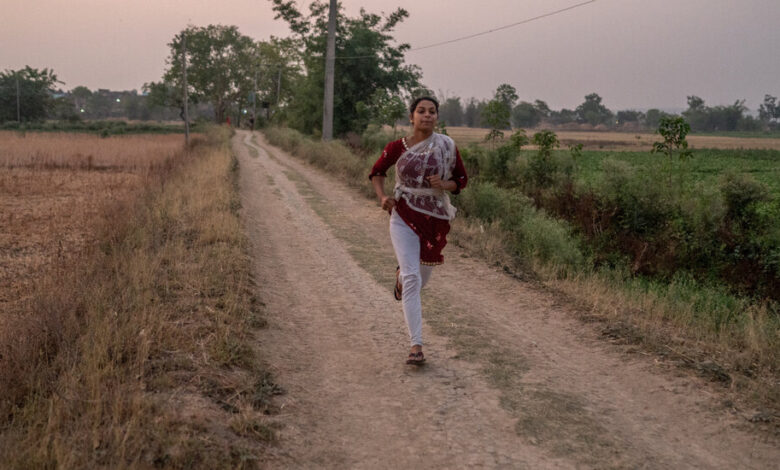In India’s embattled news media, women are fighting to be heard

Not many outsiders come to Belarhi, a remote agricultural village in northern India. Yet during reporting trips there for the recently published series India’s Daughters, New York Times journalists were always shown great hospitality.
On our first trip to the village in March 2022, my colleague Shalini Venugopal Bhagat and I arrived to find Arti Kumari, one of the lead subjects of our series, and her family fully assembled. Her mother, Meena, had taken the day off work to greet us. Arti and her sister, Shanti, sent away the elementary-school-age children they usually tutored in math and Hindi. Their father, Anil, a farmer, left the fields early. The walls of their home were freshly painted. Rangoli — ornamental chalk drawings — adorned the clean-swept floors. A delicious feast simmered on the open stove.
My colleagues and I began India’s Daughters with a question: Why were Indian women leaving the work force?
Our first reporting obstacle was access. Not all women in India can freely speak to journalists, as I found in my four years there. If I went somewhere with a male photographer or reporter, his presence alone could make an interview impossible.
Women I tried to speak to were often swarmed by relatives, elders or concerned bystanders, who insisted upon chaperoning and interpreting or even speaking for them. It was impossible to get women to speak openly in this environment. Men in the communities we visited would not allow it.
In addition, foreigners are viewed warily in some areas, an attitude that has become more common under the government of Prime Minister Narendra Modi. Many in his party have a “conspiratorial mind-set,” as the political scientist Pratap Bhanu Mehta has put it, that views criticism from outside the country as an attempt to hamper India’s ascension on the world stage.
Being an all-female reporting team proved helpful. In the villages and urban enclaves where our reporting took us, it would have been viewed as highly inappropriate, and even dangerous, for a male stranger to speak alone to a woman. But we were granted rare access to the private lives of the subjects of our stories, without male supervision.
We were asking a lot of the women we interviewed: to be vulnerable and honest as they talked about their dreams and ambitions and the pressure from family and their communities to marry. And we felt that they spoke freely, without shame or fear.
Under Mr. Modi, journalism has increasingly come under attack. Local reporters have been jailed, the foreign press has been derided as anti-India, and female journalists have faced misogynistic trolling and harassment.
The fourth estate had flourished in India, the world’s largest democracy, along with cheap, widespread internet, but has increasingly clashed with the political ideology of Hindu nationalism. Mr. Modi is an incredibly popular politician, and many of his supporters view him as an all-knowing father figure above reproach — and any criticism of him as a sort of blasphemy.
The government has used antiterror laws to silence journalists. Recently, the police in New Delhi raided the homes and offices of journalists who worked for a left-leaning news portal known for its criticism of the Modi government. Rules enacted in 2021 empowered the government to take down or change online content if it prompted a barrage of complaints — never mind that pro-government trolls were often behind the barrage.
Though many journalists continue to report on subjects that make them targets, a culture of fear and self-censorship has taken root.
Female journalists in particular have been targeted for harassment, according to the Committee to Protect Journalists.
“This political dispensation believes in an ideology that is extremely rooted in patriarchy and at every level undermines the intelligence of women,” said Neha Dixit, an award-winning investigative reporter in Delhi. “They find it even more offensive when a woman is critical,” she added.
For seven years, Ms. Dixit has been battling court cases filed against her for a report that accused R.S.S. — a militant organization devoted to making India a Hindu state, and the fountainhead for Mr. Modi’s party, the B.J.P. — of trafficking Indigenous children from Assam to Punjab and Gujarat for the purpose of political and religious indoctrination. Members of the B.J.P. denied the allegations in a lawsuit against Ms. Dixit and the magazine that published her reporting.
After her report in 2016, Ms. Dixit received threatening calls from hundreds of phone numbers, with men threatening to gang-rape her or throw acid on her face. A group of men tried to break into her home in 2021, she said.
Many of the women who have entered journalism in the last decade had to overcome resistance from their own families first, Ms. Dixit said.
“It’s not viewed as something ‘good’ women do,” she said. “In many places, women are fighting to be in that public space, to openly question, critique or tell the world what they’re thinking. That is something not appreciated in a patriarchal society like India.”
As a correspondent for The Times, I enjoyed many protections that Indian journalists did not have. But being a foreign woman made me a target in other ways.
In the later stages of our reporting, an incident threatened to jeopardize the trust we had established with our subjects and the series itself.
In May 2022, a pro-Modi commentator with a large following falsely claimed in an online video that I was anti-Hindu, setting off a furor so loud that it reached Arti in remote Belarhi.
On social media, I was flooded with messages demanding that I leave India.
“This woman has no right to speak about our culture and religion,” one viewer wrote on YouTube. “Does she have the guts to open her big mouth in any other country? What is she doing here anyway, apart from trying to show us in bad light?”
A conservative anchor on a right-wing cable TV news show focused an entire segment on the claims.
Arti began to doubt our motives at a critical time in her life and in our reporting — the lead-up to her wedding. She expressed concern to Shalini, who was able to reassure her that the video was incorrect and that I was not anti-Hindu.
My colleague Amanda Taub and three other women on our reporting team traveled to Belarhi to cover Arti’s wedding as planned. We could continue to witness these women’s lives up close.
Other journalists in India, tied up in legal cases or silenced by real or threatened retribution, would not be as fortunate.





